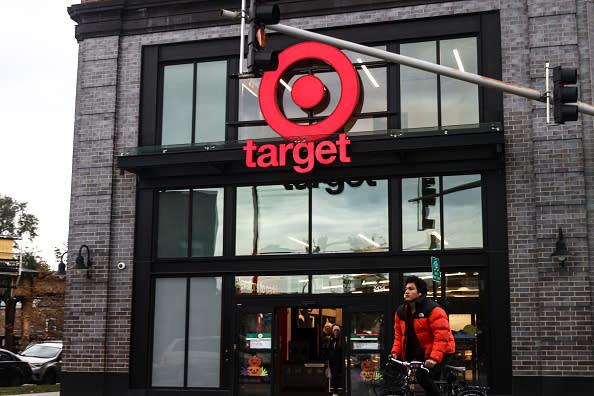‘Affordable Joy’ Helps Target Sales, but Consumers Aren’t Impulse Shopping Like They Used To

Target Corp. held its ground in the first quarter.
But the discounter has plenty of competition and continued to get battered in discretionary goods in the early innings of 2023. The company also warned that the growing and industry-wide problem of inventory shrink would sap an additional $500 million out of its earnings this year.
More from WWD
“We came into the year clear-eyed about what consumers are facing with persistent inflation and rising interest rates,” said Brian Cornell, chair and chief executive officer, on a conference call with Wall Street analysts. “And we were determined to build on the trust our guests have had in Target by unifying as a team to deliver affordable joy each and every day.”
Affordable joy, it seems, helped Target drive customer traffic up 0.9 percent in the quarter for 12 straight quarters of traffic growth.
“That’s a healthy indication of the trust, loyalty and strategic relevance we’ve created,” Cornell said. “Very few others can point to anything like that. This growth in guest engagement is the product of deliberate investments we’ve been making for many years.”
While those investments, for instance the partnership with Ulta Beauty, have helped in areas like beauty, apparel still needs a boost.
Target’s first-quarter comparable sales were flat as revenues increased by 0.6 percent to $25.3 billion. While profits slipped 5.8 percent to $950 million, earnings per diluted share came in at $2.05, a solid 28 cents ahead of the $1.77 analysts projected, according to FactSet.
Investors gave the company thumbs-up and traded its shares up 2.5 percent to $160.86.
But discretionary categories including apparel, home and hardlines saw sales declines range from the midsingle digits to the low double digits. That weakness was offset by mid-teen comp growth in beauty and strength in food and household essentials.
Cornell stood by the company’s discretionary business, which racked up nearly $55 billion in sales last year, with big gains over the pandemic.
“A short-term pullback in discretionary purchases doesn’t mean we’ll turn away from our apparel, home and hardline categories,” he said. “Instead, we’ll continue to invest in them and deliver fresh new items throughout the year. That’s because our guests continue to love these categories, and we’re focused on building our guest engagement with them.”

The CEO’s methodical approach has helped Target steadily build through the disruption of the pandemic, adding a total of more than $30 billion in annual revenues since 2019.
But Cornell isn’t the only one looking to build.
Offprice giant The TJX Cos. Inc. also reported first-quarter results on Wednesday and saw much more traction in apparel at its Marmaxx division, which includes T.J. Maxx and Marshalls in the U.S.
Marmaxx’s apparel and accessories business saw a high-single digit comp increase during the quarter, with an 80 basis point improvement in profit margin.
“We are extremely pleased with the momentum of our largest division as sales and traffic were consistent across each of Marmaxx’s regions,” said John Klinger, executive vice president and chief financial officer, in a separate call with analysts. “We continue to see an excellent opportunity for Marmaxx to capture additional market share across the U.S.”
Count that as another shot across the bow for Target, which is looking at declines headed into the second quarter, when it projected comp sales would be down in the low single digits.
For the full year, the retailer continues to project “comparable sales in a wide range from a low-single digit decline to a low-single digit increase” and operating income growth of more than $1 billion with EPS of $7.75 to $8.75.
That makes the second half particularly important for the retailer.
Neil Saunders, managing director of GlobalData, said Target saw a long period of considerable growth, but that shoppers are now simply feeling constrained.
“This takes its toll on Target, which is traditionally reliant on impulse purchasing and people loading up their carts,” Saunders said. “Unfortunately, the current consumer economy just isn’t conducive to this kind of behavior. The carefree shopping trip has been replaced by more focused missions where people set budgets and are less willing to deviate from them.
“Although some of this is outside of Target’s control, we don’t think the company has done itself any favors in trying to buck the trend,” he said. “Across some areas, like apparel, ranges lack some of the oomph and newness that once acted as a differentiator and helped to drive purchases.”

Target also called out increased trouble with shrink — an industry-wide problem.
The retailer started seeing an increase in its inventory essentially disappearing last year and said the phenomenon is now expected to take an additional $500 million out of profits this year.
“While shrink can be driven by multiple factors, theft and organized retail crime are increasingly urgent issues, impacting the team and our guests and other retailers,” Cornell said. “The problem affects all of us, limiting product availability, creating a less convenient shopping experience and putting our team and guests in harm’s way.
“The unfortunate fact is violent incidents are increasing at our stores and across the entire retail industry,” the CEO said. “And when products are stolen, simply put, they’re no longer available for our guests who depend on them and, left unchecked, theft and organized retail crime degrade the communities we call home.”
Underscoring the breadth of the problem, New York City Mayor Eric Adams also weighed in on retail theft on Wednesday with a plan to combat the issue.
“Last year alone, 327 repeat offenders were responsible for 30 percent of the more than 22,000 retail thefts across our city,” Adams said. “This hurt our businesses, our workers, our customers, and our city.”
Best of WWD


